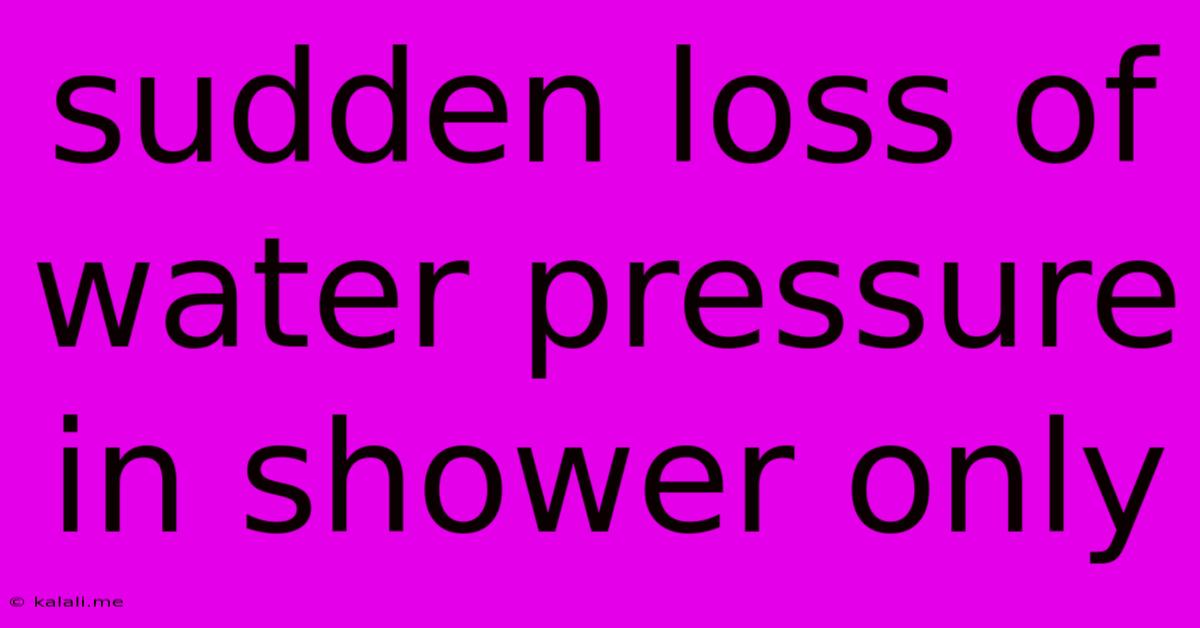Sudden Loss Of Water Pressure In Shower Only
Kalali
Jun 09, 2025 · 3 min read

Table of Contents
Sudden Loss of Water Pressure in Shower Only: Troubleshooting Guide
Experiencing a sudden drop in water pressure, specifically in your shower, can be incredibly frustrating. You're ready for a relaxing shower, and instead, you're met with a weak, sputtering stream. This isn't just an inconvenience; it can point to several underlying issues within your plumbing system. This comprehensive guide will walk you through the most common causes and how to troubleshoot them. We'll cover everything from simple fixes you can tackle yourself to when you might need to call a plumber.
Understanding the Problem: Why Only the Shower?
The fact that only your shower is affected points to a problem localized to that fixture, rather than a broader water pressure issue affecting your entire house. This narrows down the potential culprits considerably.
Common Causes and Solutions
1. Clogged Showerhead: This is the most common and often easiest fix. Mineral deposits, soap scum, and hair can accumulate in the showerhead's nozzles, restricting water flow.
- Solution: Remove the showerhead (usually unscrews) and soak it in a solution of white vinegar and water for about an hour. Use a small brush or toothpick to gently scrub away any stubborn deposits. Rinse thoroughly and reattach.
2. Faulty Shower Cartridge or Valve: The cartridge or valve controls the water flow to your shower. Over time, these components can wear out, become damaged, or simply fail, resulting in low water pressure.
- Solution: This typically requires replacing the cartridge or valve. While this is a more involved repair, it's often manageable for DIY enthusiasts with some plumbing experience. You'll need to identify the type of valve you have (e.g., cartridge, compression) before purchasing a replacement. Numerous online tutorials can guide you through the process, but if you're unsure, it's best to call a plumber.
3. Kinked or Restricted Supply Line: The pipes supplying water to your shower can become kinked or restricted, reducing water flow. This is particularly likely if the pipes are flexible or located in areas where they might be easily compressed or bent.
- Solution: Inspect the supply lines carefully. If you find a kink, gently try to straighten it. If the lines are severely damaged or beyond repair, you may need to replace them.
4. Low Water Pressure in the Entire House (But More Noticeable in the Shower): While the problem seems isolated to the shower, a slightly reduced water pressure across the whole house might become more pronounced in areas with smaller-diameter pipes, such as the shower.
- Solution: Check other faucets and appliances. If low pressure is widespread, the problem may lie with your main water supply, a clogged water meter, or issues within the main water lines. You may need to contact your water company or a plumber.
5. Sediment Buildup in Pipes: Over time, sediment and minerals can accumulate inside your pipes, reducing water flow. This is especially common in older homes or areas with hard water.
- Solution: This is a more complex issue and may require professional help. A plumber might need to flush your pipes to remove the sediment buildup.
6. Air in the Lines: Trapped air in the water lines can also cause reduced water pressure. This is less common but can still occur.
- Solution: Turning on all taps in your house, starting with the ones farthest from the main water supply, can help release trapped air. Let the water run for a few minutes to see if the pressure improves.
When to Call a Plumber:
If you've tried the basic troubleshooting steps and still have low shower pressure, it's time to call a professional plumber. Don't attempt complex repairs if you lack the necessary skills and experience, as you risk causing further damage to your plumbing system. A plumber can accurately diagnose the problem and provide the appropriate solution.
By systematically investigating these potential causes, you'll be well on your way to restoring the satisfying, full-pressure shower you deserve. Remember safety first, and don't hesitate to call a professional when necessary.
Latest Posts
Latest Posts
-
How Many Records Can Sfdc Flow Can Handle
Jun 09, 2025
-
How To Wire A Outlet To A Switch
Jun 09, 2025
-
When Can Kittens Be Given Away
Jun 09, 2025
-
Is The Hobbit Apart Of Harry Potter
Jun 09, 2025
-
Can You Touch Hindu Murtis If You Eat Meat
Jun 09, 2025
Related Post
Thank you for visiting our website which covers about Sudden Loss Of Water Pressure In Shower Only . We hope the information provided has been useful to you. Feel free to contact us if you have any questions or need further assistance. See you next time and don't miss to bookmark.